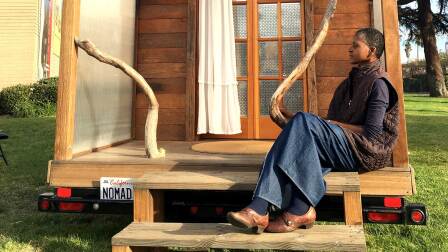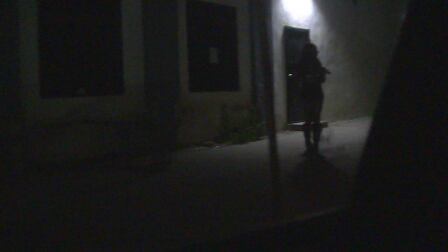
Urban Beekeeping: What's the Buzz About?
For the first time in more than a century, the Los Angeles City Council officially legalized urban beekeeping in single family homes in October 2015, catching up with cities like Santa Monica, New York, and Santa Barbara in permitting backyard beekeeping.
But now, what will it take to create a new generation of beekeepers? Can computers and smartphone apps help make the traditional task of beekeeping more inviting?
There's no question that backyard beehives face multiple challenges. One expert, Kelton Temby, calls them the four P's: Pests, pesticides, poor management, and pathogens. He has come up with a high-tech monitor to gauge the health of beehives remotely. What does this technology have to offer aspiring beekeepers?
In this segment of "SoCal Connected," reporter Cara Santa Maria introduces us to beekeepers from Los Angeles and Santa Barbara and finds out what backyard beekeeping is doing to support the honey bees of Southern California.
Featuring Interviews With:
- Sylvia Henry, urban beekeeper
- Kelton Temby, founder, EyesOnHives
- Michael Stivers, beekeeper
Transcript
Cara Santa Maria: I never imagined I’d find myself face-to-face with thousands of buzzing honey bees. But I’m strangely unafraid. In fact, I’m captivated. The beehive is a marvel of efficiency, beauty, cooperation. It’s no wonder human beings have been keeping bees for over 4,000 years. Yet for the past century, a hive in your own backyard in Los Angeles meant you were breaking the law. Even more bizarre, the ordinances were in place because officials actually thought the bees were attacking our fruit. We know better now. Bees don’t hurt our food supply, they are vital to it. In fact, without their pollinating powers, around 75 percent of our fruits, nuts, and vegetables would never make it to the table. Luckily we’ve wised up and the ban has been lifted.
Sylvia Henry: Well thank goodness that the council was able to pass the ordinance that allowed bees in Los Angeles. Because before there were a lot of us that were simply illegal beekeepers.
Cara Santa Maria: Sylvia Henry’s parents and grandparents tended bees. She grew up eating fresh honey.
Sylvia Henry: We thought that comb honey was the only way that honey was any good. It’s certainly better than any honey you’re going to get in the store.
Cara Santa Maria: A couple of years ago, Sylvia decided to continue her family tradition and get a beehive of her own.
Sylvia Henry: When I first got the hive, I spent a lot of time just hanging about 8 feet away and I could just watch them because they are fascinating.
Cara Santa Maria: Now that beekeeping is legal in L.A., many others will want fresh honey and great pollinators in their backyard. But how do you make sure your beehive thrives? Nice to meet you, so what are we working on now? That’s what beekeeper Kelton Temby has been working on. I met him in his backyard in Santa Barbara. We took a look inside one of his thriving beehives.
Kelton Temby: I’m going to get you to gently put a little bit of smoke in the cover.
Cara Santa Maria: We took a look inside one of his thriving beehives. And so what does this smoke do?
Kelton Temby: And so the smoke is calming the bees down. They think that they are in survivor mode.
Cara Santa Maria: You can tell who the real beekeeper is. Kelton doesn’t even wear gloves.
Kelton Temby: Here’s our live bees, we are seeing some pollen in here.
Cara Santa Maria: Beekeeping has been legal in Santa Barbara since the 70s, so beekeepers here are familiar with all of the things that can kill a hive. They call them the four “Ps”: pathogens, like viruses and fungi; pets like ants and mice; poor management and pesticides which may be contributing to Colony Collapse Disorder. You can’t spot these problems unless you open the hive, but you don’t want to do that too often because it really disturbs the bees. Kelton thought there had to be a better way.
Kelton Temby: I thought well why isn’t there healthcare for bees? What can we do here with technology to maybe help?
Cara Santa Maria: Kelton isn’t just a beekeeper; he also happens to be a medical robotics engineer. He realized you can tell how the bees are doing by analyzing their flight patterns. So he and his team invented a system that does just that.
Kelton Temby: So EyesOnHives is like a heart rate monitor for a beehive. A little like you have a FitBit to measure your heart rate, the bees now have this device to measure theirs. So here’s one of the devices we’ve developed, and this is what we call EyesOnHives Model B.
Cara Santa Maria: Oh, nice. It’s kind of looks like a security camera.
Kelton Temby: It does. What we’re doing is we’ve got a small but powerful computer inside there, coupled to a camera and what the camera is doing is it’s recording videos of the hive entrance activity and the computer is actually processing that. It’s running an algorithm to determine how many bees are flying and we are using that data to let the beekeepers know what their hive is doing.
Cara Santa Maria: And that’s the little blue outlines on the bees, when we’re looking at the video feed? And get this, when baby bees are ready to leave the hive, they kind of hover around the front practicing their flight. It’s a distinct pattern. Kelton and his team discovered they could track and measure it with EyesOnHives- they call it the heartbeat of the hive.
Kelton Temby: We’re getting this heartbeat signature that really tell us…you know, it’s sort of like when the bees are taking that first flight..so it’s signal is really jumping out at us saying this is a healthy hive that is growing that has healthy young bees, this is a good sign.
Cara Santa Maria: But sometimes beehives do fall victim to the four Ps. Kelton’s friend Mike’s hive was invaded by Argentinian ants.
Kelton Temby: It was really upsetting. The ants would drag out these sort of the baby bees, and you’d see them dragging out these bees and eating them and killing off the rest of the hives.
Cara Santa Maria: Using Kelton’s system, Mike was able to catch the danger early and intervene to save his bees.
Michael Stivers: I was great to have EyesOnHives camera. If you’re just going out on weekends, you might miss an emergency like that.
Cara Santa Maria: To make monitoring even more convenient, Kelton developed an integrated app.
Kelton Temby: This data is actually sent over the internet and it goes up to the Cloud and down to your smartphone. So I can take my smartphone and I can check in when I’m standing in line at the grocery store on what my bees were doing that day and I can see their activity patterns over time.
Cara Santa Maria: Sylvia Henry is a farm girl at heart. At her Los Angeles home, she tends bees the old-fashioned way. So when I asked if she’d want to go high-tech and use EyesOnHives, her answer surprised me.
Sylvia Henry: That would be fun, I mean that would be really fun.
Cara Santa Maria: You’d like to watch your bees through your smartphone?
Sylvia Henry: Absolutely.
Cara Santa Maria: Advances like EyesOnHives won’t solve Colony Collapse Disorder or make bees less attractive to hungry ants, but it could make bees more accessible to busy city dwellers.
Kelton Temby: Building tools that allow people to do this in the 21st century, it’s like you can be a beekeeper, you can be an organic farmer, you can do all these wonderful things that help the environment in your own backyard.
Cara Santa Maria: A lot has changed since backyard beehives were first outlawed in L.A. Technology is modernizing beekeeping right at a time when bees can use all the help they can get. I’m Cara Santa Maria for “SoCal Connected.”























